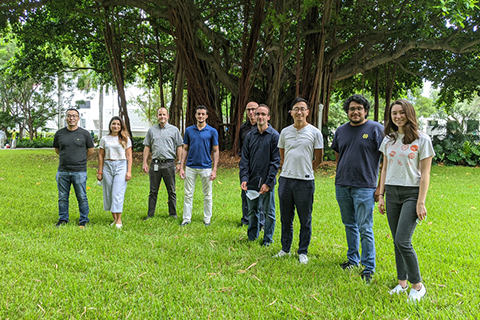Connecting Mind to Machine: University of Miami Team Moving Forward on DARPA Project to Revolutionize Non-surgical Brain-Computer Interface
UM News, 11-23-2020

Researchers have made groundbreaking strides in brain-computer interface (BCI) research, allowing individuals to connect mind to machine and control devices with their brains. The Defense Advanced Research Projects Agency (DARPA) wants to tap into this breakthrough technology and develop a non-surgical option that provides a new way for able-bodied individuals to interact with machines.
As part of the BrainSTORMS team, the University of Miami officially entered Phase II of the DARPA Next-generation Non-surgical Neurotechnology (N3) program. The objective of the N3 program is to revolutionize the non-surgical BCI to enable fast, effective, and intuitive hands-free interaction with military systems by able-bodied service members. To achieve this ambitious goal, DARPA selected a handful of cross-disciplinary and multicampus teams across the nation. Each team proposed innovative science at the intersection of neuroscience, physics, and engineering to achieve the ambitious goals of the N3 program.
The BrainSTORMS team used a nanotechnology concept proposed for the first time by the University of Miami’s Sakhrat Khizroev, a professor in the College of Engineering’s Department of Electrical and Computer Engineering, and Dr. Ping Liang, co-founder of Cellular Nanomed (CNMI), in 2010. According to this concept, wireless bidirectional interface can be created with magnetoelectric nanoparticles (MENPs). These nanoparticles have a diameter of less than 50 nm, thus allowing them to cross the blood-brain barrier (BBB), and then, when in the brain, tap into the nervous system at the sub-neuronal level and provide a critical two-way communication link between the computer and the brain. This link is enabled owing to the MENPs’ unique quantum-mechanical physics, allowing for efficient correlation between externally controlled magnetic fields and intrinsic local electric fields due to neural activity deep in the brain. Because of the physics, information could be transmitted in and out of the brain with record high spatial and temporal resolutions.
Throughout its impressive history, DARPA spearheaded many groundbreaking technologies which shaped our lives today – with the internet being one of them. The potential impacts the N3 program could make are beyond this BCI technology, ranging from revolutionary medicine to next-generation computing and Artificial Intelligence. The contactless BCI will finally allow to tap into the brain with unprecedented spatial and temporal resolutions to literally see and understand how the computing architecture of the brain works.
 During Phase I, the team demonstrated the novel engineering concepts based on the proposed physics, by conducting experiments in vitro and in vivo (on rodents). The goal of the 18-month Phase II period is to build first working devices, which then could be translated into clinical studies during Phase III.
During Phase I, the team demonstrated the novel engineering concepts based on the proposed physics, by conducting experiments in vitro and in vivo (on rodents). The goal of the 18-month Phase II period is to build first working devices, which then could be translated into clinical studies during Phase III.
The BrainSTORMS team, which includes members from the University of Miami and CNMI, also includes Battelle – which serves as the lead organization – Indiana University, Carnegie Mellon University, and Air Force Research Laboratory (AFRL). The Khizroev-led team at the University of Miami includes graduate students Mostafa Abdel-Mottaleb, Yagmur Akin Yildirim, Manuel Campos Alberteris, Brayan Navarrete, Dennis Toledo, and Elric Zhang, as well as undergraduate student Isadora Takako Smith.